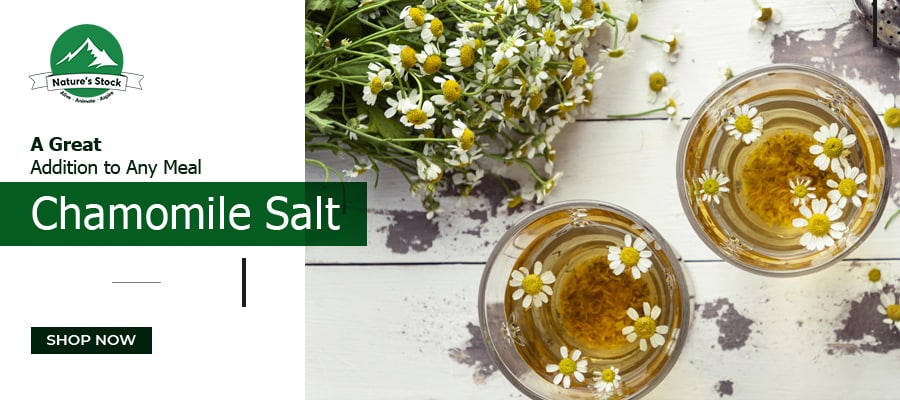Chamomile or camomile is the common name for several daisy-like plants of the family Asteraceae. Two of the species are commonly used to make herbal infusions for traditional medicine. It has been consumed for centuries as a natural remedy for several health conditions.
The chamomile plant’s flowers and buds are harvested for tea as the flowers open. It continually blooms for a few months, depending on the climate in which it’s grown. After harvest, the flowers are dried to prolong the shelf life. When this occurs, the white petals turn a pale yellow and may fall off the yellow head, which is its most recognizable form.
Organic Herbs
These magnificent herbs are the foundation of any gourmet cook’s larder. When herbs cultivated organically are used to make seasoning mainstays like basil, cinnamon, curry powders, spice blends like Cajun Spice, Fajita Seasoning, and many more, the flavor is richer. You may even buy organically made salt, which you can use in a variety of recipes in your home.
Teas made from herbs can also be consumed. Teas are not only tasty, but they also contain little to no caffeine. Chai tea, chamomile tea, lemon or orange spice teas are all popular flavors, and you may even make your own specialty tea mixes using your favorite herbs and spices.
In addition, essential oils used in aromatherapy are made from organic herbs. Aromatherapy creates pure and concentrated oils by extracting oils from organically grown plants. The essential oil is placed in a diffuser, which heats the oil and releases the seductive aroma.
Organic herbs can be utilized as an ingredient in bath products, which is one of the greatest ways to use them. Nothing beats filling a cheesecloth drawstring bag with a lovely herbal bath blend and soaking it in the bath water to release the scent not just in the wet air but also onto your skin.
Restaurants and stores that make and sell their own herbal goods, such as soaps, find that employing organically produced herbs is a compelling selling factor that boosts sales. Organic herbs can be acquired in bulk for use as ingredients in enterprises or for sale to the general public.
Anne Harvester is a herbalist who has researched the advantages of using organic herbs and other goods. She looks at organic essential oils, organic teas, and organic spices in this essay.
1. Digestive System
As its many names allude to, chamomile is the King of the Herbs when it comes to any kind of digestive complaint. Known as “Our Lady of the Guts” or “Mother of the Gut”, this versatile herb contains a complex collage of phytochemicals that work individually and collectively on all aspects of the digestive system. A-bisabolol speeds the mending of torn tissue which assists the healing of ulcerations. Chamazulene shrinks swollen stomach tissue that presses on nerve endings causing pain. Azulene kills staphylococcus and streptococcus infections, which in turn can alleviate the symptoms of food poisoning.
Often the root of digestive upset, nervousness can be calmed by this mildly sedative herb. Chamomile Salt contains one flavonoid in particular, apigenin, which binds to the benzodiazepine receptors in the brain, promoting relaxation. Stress is a well-known factor in IBS flare ups. Because the brain and the gut communicate directly back and forth via the vagus nerve, a more relaxed mind can also help heal gut issues, which can mean reduced symptoms of chronic conditions like leaky gut, IBS and other gut-related issues.
Stomach upsets and bugs can also be relieved by chamomile – its delicate balance of active plant compounds will help to neutralize the cause and heal any damage induced by the bug.
2. Anti-Anxiety/Sedative
As a relaxant, chamomile depresses the central nervous system, reducing anxiety while not disrupting normal performance or function. This is due to the active principles of chamomile including flavonoids, glycosides, and essential oils.
In a 2011 study published in the journal, “European Neuropsychopharmacology”, showed that the phytochemicals in chamomile have 3 effects on the central nervous system that contribute to the herb’s anxiolytic and sedative properties. It binds to the GABA receptors which in turn reduces the activity of the cells in the sleep center of the brain.
3. Anti-Inflammatory/Pain Relief
Sometimes called “herbal aspirin”, chamomile has been used for centuries to lower pain and reduce inflammation. This seems to be backed up by science, with a 2009 study by Srivastava et al published in “Life Sciences,” finding that chamomile caused cell reactions similar to that of nonsteroidal anti-inflammatory drugs.
It is a popular remedy for inflammation on the outside of the body too, with it being commonly used to treat sunburn, mild burns, rashes, sores and eye inflammation.
4. Lowers Blood Sugar
A promising Iranian study from 2015 found that drinking 3 cups of chamomile tea daily could improve the control of blood glucose levels in people with type 2 diabetes. 64 participants with type 2 diabetes were recruited, all of whom were aged between 30 and 60. They consumed camomile tea three times per day immediately after meals for eight weeks. A control group also followed this routine, but they drank water instead.
The camomile tea group had significantly reduced HbA1c and serum insulin levels, as well as significantly increased total antioxidant capacity compared to those in the control group.
The researchers concluded that camomile tea could be useful in reducing diabetes risk factors. They added: “Short-term intake of chamomile tea has beneficial effects on glycaemic control and antioxidant status in patients with type 2 diabetes”.



